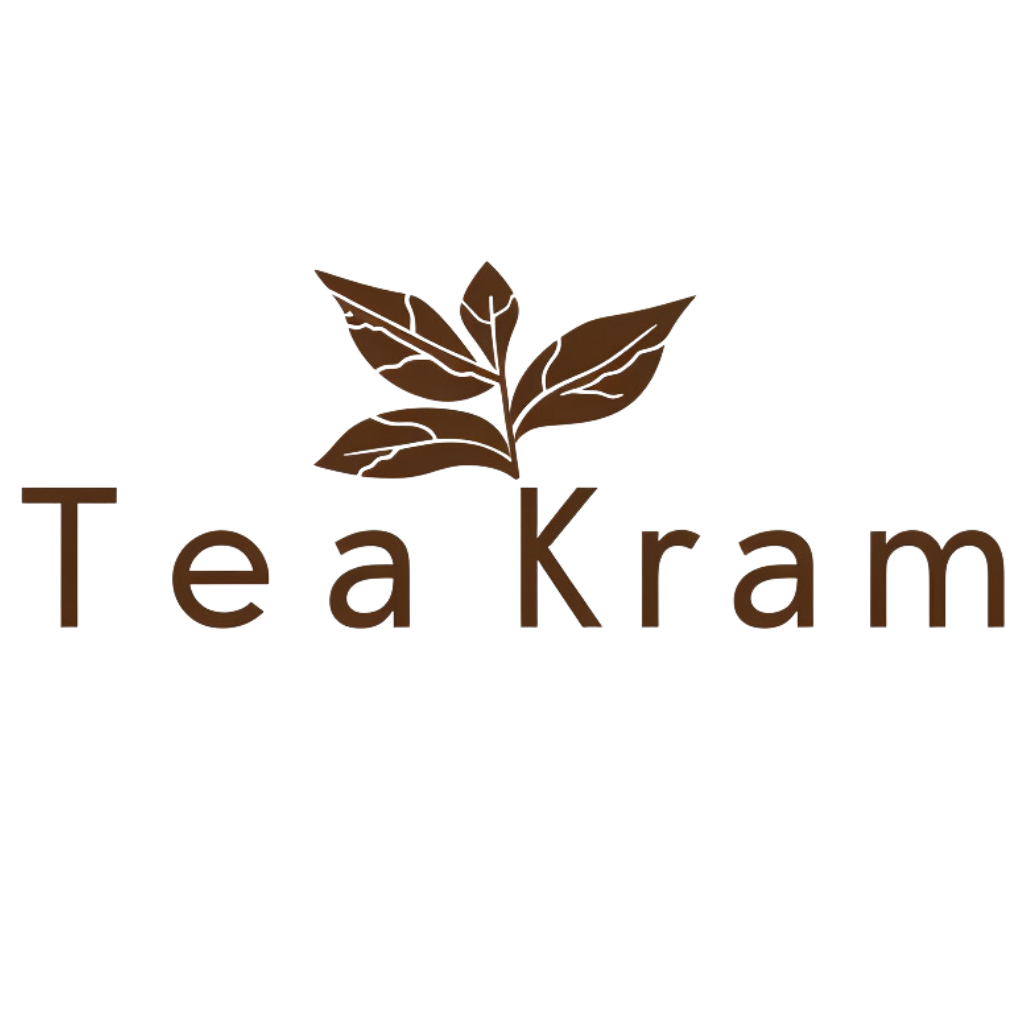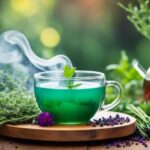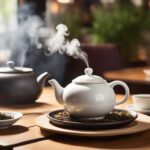Mastering Pu-erh Tea Preparation Methods is truly an art. This special dark tea comes from the ancient tea trees of Yunnan. It takes skill to bring out its best flavors. Our guide shows you how to make pu-erh tea, step by step. It covers different traditions and practices. This way, even beginners can learn the fine points of this famous drink. Whether you want a peaceful brewing ritual or just a tasty cup, our guide sets the foundation for your tea journey.

Key Takeaways
- Understanding Pu-erh tea’s unique characteristics is crucial for proper brewing.
- Selection of appropriate teaware greatly influences the quality of your Pu-erh tea experience.
- Water temperature plays a significant role in extracting the desired flavors of Pu-erh tea.
- Familiarizing yourself with various brewing techniques such as Grandpa style, Gong Fu Cha, and Western can enhance personal enjoyment.
- Minor adjustments in the brewing process can significantly refine your cup of Pu-erh tea.
Understanding Pu-erh Tea and Its Unique Characteristics
The story of traditional pu-erh tea brewing began in Yunnan province, China. This is where Pu-erh tea comes from. It’s known for its special post-oxidation process. This makes it different from oolong or black teas. Thanks to a unique fermentation that can take years, Pu-erh tea has a deep flavor. It’s a favorite among tea lovers because of its complex taste and rich history.
Pu-erh comes in two main types: raw (Sheng) and ripe (Shou). Sheng Pu-erh starts as green tea leaves pressed into cakes and aged. Sometimes this aging lasts for decades. On the other hand, Shou comes from black tea leaves. Their oxidation is sped up through a method known as piling. This rich history and method give Pu-erh its detailed classification system. This system tells drinkers about the tea’s year of production, grade, and origin factory. It sheds light on its quality and respected traits.

With a legacy that spans centuries, the traditional pu-erh tea brewing ritual is as much an art as it is a science, aiming to draw out the nuanced symphony of flavors that Pu-erh tea has to offer.
To truly understand Pu-erh’s unique nature, one must recognize how aging enhances its flavor. This process matures the tea, often hitting its peak in quality after seven years or more. Thus, brewing Pu-erh tea is about skill, patience, and honoring the tea’s natural evolution.
| Tea Type | Oxidation | Flavor Profile | Aging Potential |
|---|---|---|---|
| Sheng (Raw) | Natural, slow oxidation | Varies with age; young Sheng is often more grassy, aged develops richer, deeper notes | Decades |
| Shou (Ripe) | Accelerated oxidation | Earthy, woody, and smooth with a quicker maturity | Less aging required compared to Sheng |
This article has explored the significant differences and methods behind Pu-erh tea. Now, with a greater appreciation for the Pu-erh tea infusion process, fans can dive into traditional pu-erh tea brewing. They do so knowing more about the tea’s deep heritage and transformative qualities.
Pu-erh Tea Preparation Methods
Starting your Pu-erh Tea journey means learning how to prepare it right. These brewing tips not only make your tea taste better. They also honor its long history. Here’s some advice for those wanting to get into Pu-erh tea.
Selecting the Right Teaware for Pu-erh Tea
Choosing the right teaware is key to the best Pu-erh tea experience. The teaware affects how well the tea keeps its heat. It also affects how it smells and brews. You should use top-notch teacups, gaiwans, or Yixing teapots to keep your tea hot.
How to Break Apart a Pu-erh Tea Cake
When you get a Pu-erh tea cake, you’ll need a tea knife to break it. You have to be gentle to not smash the leaves. This keeps the tea from getting too bitter. Handling these tea cakes carefully makes for a good brew.
Optimal Water Temperature for Pu-erh Tea
The best water temperature for Pu-erh tea is between 195°F to 212°F. This depends on the tea type and what you like. The right temperature brings out the best in Pu-erh tea without burning the leaves.

Using these Pu-erh Tea steeping techniques will make tea brewing special, not just routine. As you get better at these tips, you’ll discover more about Pu-erh tea. This creates a perfect mix of tradition and personal taste in every cup.
Exploring Various Brewing Techniques for Pu-erh Tea
Starting a journey into Pu-erh tea brewing opens up a world full of scents and complexity. Each method lets us deepen our understanding of Pu-erh tea’s traditions and innovations. Let’s look into some Pu-erh tea brewing tips and traditional Pu-erh tea brewing methods loved by both experts and everyday tea drinkers.

Traditional Gong Fu Cha Method
The Gong Fu Cha way is all about appreciating the subtle changes in Pu-erh tea. From the first rinse to the many quick infusions, every action is deliberate. Small teapots or gaiwans are used to make sure each brew has a perfect mix of taste and smell. Here is a simple guide to this traditional Pu-erh tea brewing method:
- Warm the teaware with hot water then get rid of this water.
- Add the right amount of Pu-erh tea to the teapot.
- Quickly rinse the leaves with hot water to wake them up, then pour out the rinse water.
- Add hot water again, steeping for just 5 to 20 seconds.
- Enjoy the smell and taste after each steep, increasing the time bit by bit.
Modern Grandpa Style Brewing
Grandpa style brewing is a laid-back method that simplifies Pu-erh tea making. Drop a big bunch of tea leaves into a cup, then add hot water. The leaves unfold and drop, offering a simple but real tea-drinking moment. You can keep adding water to adjust the strength. It’s perfect for those who like taking their time with tea, without needing lots of gear.
Western Brewing Practices for Pu-erh Tea
Western brewing mixes Pu-erh tea into our busy lives without losing its classic charm. It’s easy for newcomers to Pu-erh or anyone looking for a quick method. Using a teapot strainer, you steep the tea for longer, starting at about three minutes. You can re-steep, depending on the tea’s quality.
No matter the method, Pu-erh tea brewing tips stress starting with high-quality water and tweaking to your liking. Whether it’s the ceremonial Gong Fu Cha, cozy Grandpa style, or easy Western way, there’s a method for everyone. Each shows Pu-erh tea’s richness and adaptability.
Enhancing Your Pu-erh Tea Experience: Brewing Tips and Variations
If you love pu-erh tea, you know there’s more to it than just brewing. You can make your tea experience better with pu-erh tea infusion modifications. The right optimal water temperature for pu-erh tea is key. It’s between 195°F to 212°F. This makes sure your tea is rich in flavor and tradition.

Getting the water temperature right is crucial, but there’s more you can do. Small changes in how you brew can deeply affect your tea’s taste. Here are some tips to add a personal touch to your pu-erh tea preparation:
- Measure with Mindfulness: Change the amount of leaves to find what strength you like best. Try starting with 3-5 grams per 200ml of water.
- Tweak Infusion Times: Adjusting how long you steep your tea can bring out new flavors. It makes your tea more interesting.
- Filtered Water Finesse: Use filtered water to make your tea taste better. It removes harsh minerals from tap water.
- Elevate with Additives: Adding things like chamomile or ginger can complement pu-erh’s earthy taste beautifully.
- Meticulous Storage: Store your pu-erh properly to keep its unique flavor and aroma. Keep it cool, dark, and dry.
But, it’s not just about these changes. Loving what you do and paying attention to detail makes brewing pu-erh special. Every part of the process, from the leaf texture to water clarity, tells a story. It combines tradition and personal touch. This makes your tea absolutely unique, just like you.
Conclusion
The beauty of making pu-erh tea is a blend of culture and personal touch. This guide has shown you the best ways to brew pu-erh tea. It blends old and new ways to bring out the tea’s classic flavors. You’ve learned how controlling the water temperature and picking the right teaware is key. These help tea lovers find the perfect balance in pu-erh tea.
There are many ways to enjoy pu-erh tea, from the careful Gong Fu Cha to the easy grandpa style, and even the simple Western way. This guide suits all types of tea lovers. Trying these methods shows how flexible and deep pu-erh tea can be. Each way is more than just tradition. It lets you add your personal touch to your tea experience.
Now, you’re ready to explore pu-erh tea’s unique flavors. You have the knowledge to make a cup that matches your taste. This journey is not just about trying a type of tea. It’s about keeping the tradition of pu-erh tea alive in every cup. Enjoy this ritual that connects history, flavor, and culture.


